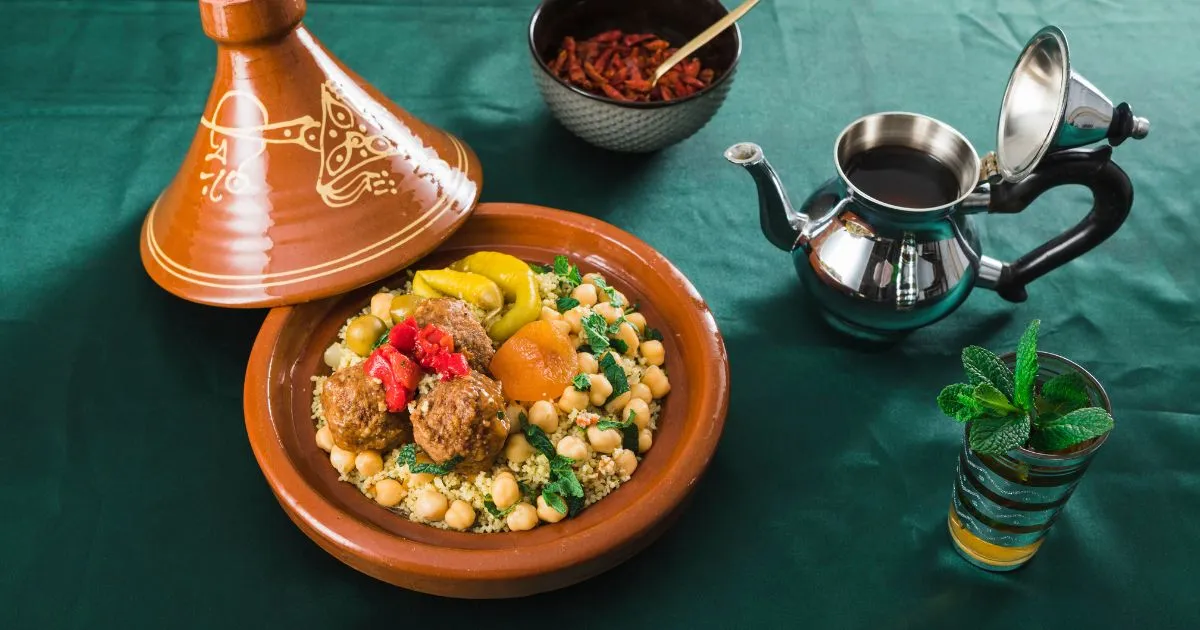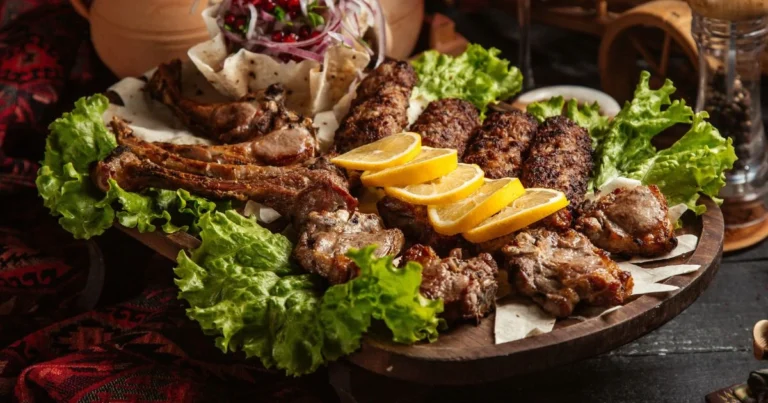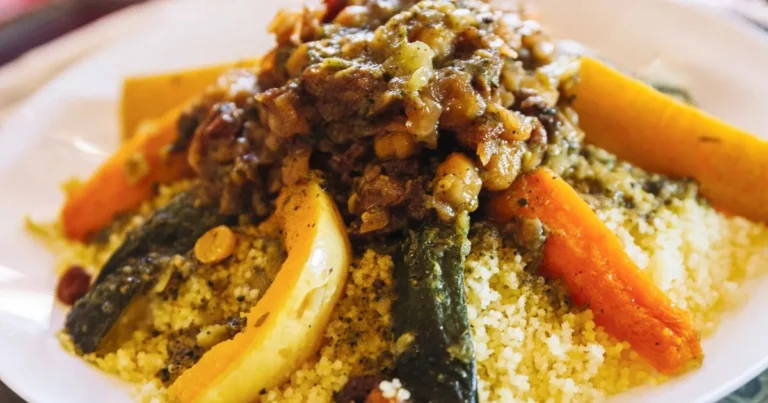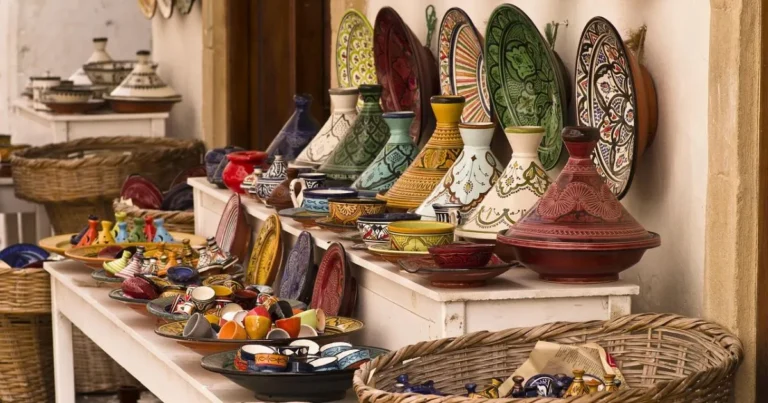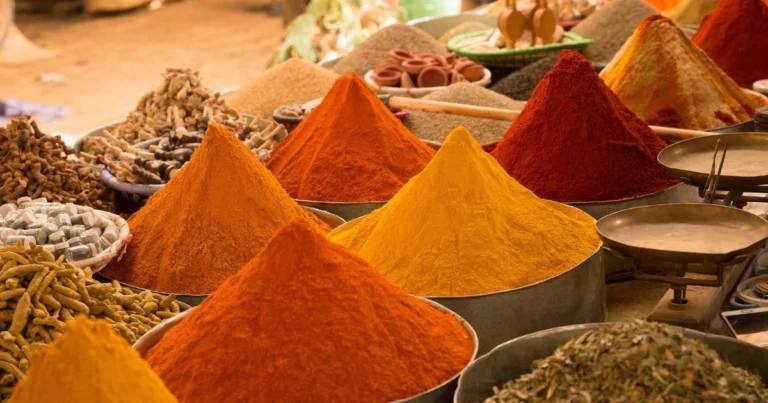The Ultimate Guide to Moroccan Cuisine: A Journey Through Morocco’s Rich Culinary Heritage
Table of Contents
Moroccan cuisine stands as one of the world’s most captivating and complex culinary traditions, weaving together centuries of cultural exchange, indigenous ingredients, and time-honored cooking techniques. From the bustling souks of Marrakech to the coastal cities of Casablanca, this North African nation offers a gastronomic adventure that tantalizes all senses with its aromatic spices, vibrant colors, and extraordinary flavors.
This comprehensive guide will take you on an immersive journey through the heart of Moroccan cuisine, exploring everything from ancient cooking methods to modern interpretations of traditional Moroccan dishes. Whether you’re a curious food enthusiast, a home cook eager to master Moroccan recipes, or someone planning to experience Morocco’s culinary landscape firsthand, this ultimate resource will provide you with the knowledge and inspiration to appreciate this remarkable cuisine fully.
History and Origins: The Tapestry of Moroccan Culinary Evolution
Ancient Foundations and Indigenous Influences
The story of Moroccan cuisine begins with the indigenous Berber (Amazigh) people, who laid the foundation for what would become one of the world’s most sophisticated culinary traditions. The Berbers contributed essential elements including:
- Tagine cooking: The distinctive cone-shaped earthenware vessel that characterizes much of Moroccan cuisine
- Couscous preparation: Hand-rolled semolina that remains Morocco’s national dish
- Preserved foods: Techniques for preserving lemons, olives, and meats in the harsh North African climate
- Pastoral traditions: Methods for preparing lamb, goat, and dairy products
The Arab Conquest and Islamic Influence
The 7th-century Arab invasion of Morocco revolutionized the region’s food culture and cooking traditions. Islamic dietary laws (halal) shaped food preparation methods, while Arab traders introduced:
- New spices: Saffron, cinnamon, and various Middle Eastern aromatics
- Cooking techniques: Advanced methods for bread-making and pastry preparation
- Cultural practices: The importance of hospitality and communal dining
- Religious customs: Fasting traditions that influenced meal timing and preparation
The Moorish Legacy
The Moorish dynasties, which governed regions of Morocco and Spain for hundreds of years, developed a distinctive blend of culinary traditions that enhanced Moroccan cooking through:
- Andalusian influences: Sophisticated pastry techniques and sweet-savory combinations
- Agricultural advancements: Sophisticated irrigation techniques that increased the variety of available ingredients
- Architectural impact: Kitchen designs that optimized cooking efficiency
- Artistic traditions: Elaborate food presentation and decorative techniques
French Colonial Period and Modern Adaptations
The French Protectorate (1912-1956) introduced European elements while Moroccan cooks masterfully adapted foreign influences:
- Bread-making methods: French baking practices combined with traditional Moroccan flatbread techniques
- Ingredient accessibility: New vegetables and cooking methods expanded the culinary repertoire
- Restaurant culture: Modern dining establishments that showcased traditional Moroccan dishes
- Global connections: International trade that brought new ingredients and techniques
Key Ingredients: The Building Blocks of Moroccan Flavor
The Spice Palette: Morocco’s Aromatic Foundation
Moroccan cuisine’s distinctive character comes from its masterful use of spices, each contributing unique flavors and aromas:
| Spice | Arabic Name | Flavor Profile | Common Uses |
|---|---|---|---|
| Ras el Hanout | رأس الحانوت | Complex, warm, slightly sweet | Tagines, couscous, grilled meats |
| Baharat | بهارات | Aromatic, peppery, citrusy | Rice dishes, meat preparations |
| Harissa | هريسة | Fiery, smoky, garlicky | Condiment, marinades, stews |
| Za’atar | زعتر | Tangy, herbal, nutty | Bread, vegetables, cheese |
| Chermoula | شرمولة | Fresh, herbaceous, zesty | Fish, vegetables, marinades |
Essential Aromatics and Herbs
Fresh herbs and aromatics form the soul of Moroccan cooking:
- Cilantro (Coriander): Fresh, bright flavor essential in chermoula and salads
- Parsley: Flat-leaf variety preferred for its robust flavor
- Mint: Central to Morocco’s tea culture and many savory dishes
- Ginger: Both fresh and ground varieties used extensively
- Garlic: Basic seasoning component in nearly all savory preparations
Staple Ingredients and Proteins
Grains and Legumes
- Couscous: The national grain, available in fine, medium, and pearl varieties
- Bulgur: Used in salads and side dishes
- Lentils: Red, green, and black types featured in broths and stews
- Chickpeas: Fresh, dried, and ground into flour
Proteins
- Lamb: The preferred meat, prized for its flavor and tenderness
- Chicken: Versatile protein used in countless traditional preparations
- Beef: Often used in robust stews and tagines
- Fish: Coastal regions feature abundant seafood preparations
- Eggs: Used in both savory and sweet applications
Fruits and Vegetables: Nature’s Bounty
Morocco’s diverse climate produces an impressive array of fresh ingredients:
Fruits:
- Dates: Medjool and other varieties, often stuffed or used in tagines
- Figs: Fresh and dried, adding sweetness to savory dishes
- Oranges: Sweet and bitter types, featured in salads and preserves
- Lemons: Preserved lemons are quintessentially Moroccan
- Apricots: Used both fresh and dried in tagines and sweet preparations
Vegetables:
- Tomatoes: Foundation for many sauce bases
- Onions: Yellow, red, and shallots used extensively
- Eggplant: Prepared in numerous traditional methods
- Zucchini: Stuffed, grilled, and stewed
- Carrots: Often cooked with sweet spices
Regional Variations: A Culinary Journey Across Morocco
Marrakech: The Imperial City’s Culinary Treasures
Marrakech, the “Red City,” offers a distinctive culinary experience shaped by its history as an imperial capital:
Signature Dishes:
- Tanjia Marrakchia: Meat stew slow-cooked in traditional earthenware vessels
- Pastilla: Elaborate pastry traditionally filled with pigeon or chicken
- Mechoui: Whole roasted lamb, a specialty of the region
Unique Characteristics:
- Heavy use of preserved lemons and olives
- Emphasis on slow-cooking techniques
- Complex spice blends reflecting royal cuisine traditions
- Street food culture with diverse grilled meats and vegetables
Fes: The Culinary Capital
Fes, Morocco’s spiritual and cultural heart, boasts perhaps the most refined and sophisticated cuisine in the country:
Culinary Highlights:
- Pastilla Fassia: The most refined variation of Morocco’s celebrated pastry
- Rfissa: Comfort food featuring chicken, lentils, and torn bread
- Sellou: Nutritious mixture of almonds, flour, and argan oil
Distinctive Features:
- Intricate preparation methods passed down through generations
- Emphasis on balance and harmony in flavor combinations
- Use of rare and expensive ingredients
- Elaborate presentation reflecting aristocratic traditions
Casablanca: Coastal Flavors and Modern Fusion
As Morocco’s economic capital, Casablanca offers a unique blend of traditional and contemporary culinary experiences:
Seafood Specialties:
- Chermoula Fish: Grilled fish marinated in herb and spice paste
- Sardine Preparations: Various methods showcasing the Atlantic catch
- Seafood Tagines: Combining ocean bounty with traditional cooking methods
Modern Influences:
- International fusion restaurants
- Contemporary interpretations of traditional Moroccan dishes
- Emphasis on fresh, local ingredients
- Innovative presentation techniques
The Sahara: Desert Cuisine and Nomadic Traditions
The Saharan regions offer a unique culinary perspective shaped by nomadic traditions and harsh desert conditions:
Characteristic Elements:
- Preserved Foods: Emphasis on foods that travel well and last long
- Dairy Products: Camel and goat milk preparations
- Date-Based Dishes: Creative uses for this essential desert fruit
- Simple Preparations: Focus on ingredient quality over complex techniques
Signature Preparations:
- Berber Tagines: Simple but flavorful stews using available ingredients
- Desert Bread: Flatbreads cooked on hot stones
- Nomadic Tea: Elaborate tea ceremonies central to social life
Traditional Cooking Methods: Time-Honored Techniques
The Art of Tagine Cooking
The tagine, Morocco’s most iconic cooking vessel, represents centuries of culinary evolution:
Design Philosophy:
- Conical Lid: Creates steam circulation for even cooking
- Clay Construction: Provides excellent heat retention and distribution
- Glazed Interior: Prevents sticking and easy cleaning
- Varied Sizes: From individual portions to family-sized vessels
Cooking Techniques:
- Slow Braising: Low, steady heat develops complex flavors
- Steam Cooking: Moisture circulates within the closed system
- Flavor Concentration: Minimal liquid evaporation intensifies tastes
- Gentle Heat: Prevents burning while ensuring thorough cooking
Couscous Preparation: The National Art
Preparing traditional couscous demands careful technique and considerable time:
Equipment:
- Couscoussier: Two-part steamer with perforated top section
- Wooden Spoon: For gentle stirring and fluffing
- Fine Mesh: For achieving perfect grain separation
Traditional Method:
- Initial Steaming: First cooking phase creates basic texture
- Butter Integration: Adds richness and prevents clumping
- Secondary Steaming: Develops final texture and flavor
- Final Seasoning: Last-minute additions for optimal taste
Bread Making: Daily Ritual and Community Tradition
Bread holds sacred significance in Moroccan culture, with specific techniques passed down through generations:
Traditional Varieties:
- Khubz: Daily bread with simple ingredients
- Rghaif: Flaky, layered flatbread
- Harcha: Semolina bread with distinctive texture
- Msemen: Multi-layered breakfast bread
Community Aspects:
- Neighborhood Ovens: Shared baking facilities fostering community
- Daily Rhythms: Bread-making schedules shaping daily life
- Quality Standards: Rigorous expectations for texture and flavor
- Cultural Meaning: Bread represents hospitality and nourishment
Common Dishes: The Heart of Moroccan Cuisine
Tagines: Morocco’s Signature Stews
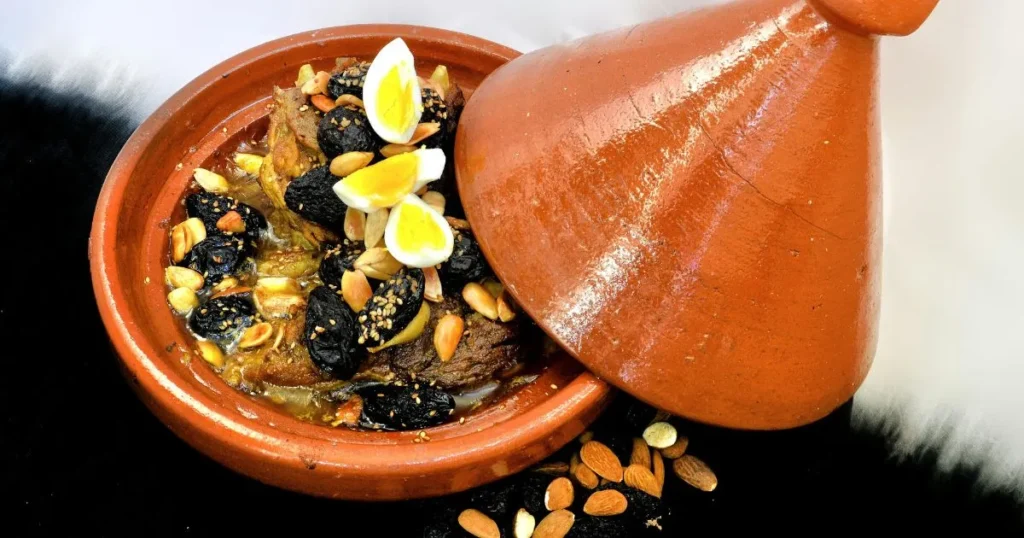
Tagines represent the pinnacle of Moroccan cooking, combining proteins, vegetables, and spices in harmonious balance:
Chicken Tagine with Preserved Lemons and Olives
This classic preparation showcases the essential Moroccan flavor combination:
Key Ingredients:
- Free-range chicken pieces
- Preserved lemons (homemade or quality store-bought)
- Green olives (preferably Moroccan varieties)
- Fresh ginger and garlic
- Saffron threads
- Fresh cilantro and parsley
Cooking Process:
- Marinate chicken with spices and herbs
- Layer ingredients in tagine base
- Cook slowly over low heat for 45-60 minutes
- Finish with fresh herbs and preserved lemon
Lamb Tagine with Apricots and Almonds
A sophisticated sweet-savory combination representing Morocco’s culinary complexity:
Distinctive Elements:
- Tender lamb shoulder: Cut into generous pieces
- Dried apricots: Provide natural sweetness
- Toasted almonds: Add texture and nutty flavor
- Cinnamon and ginger: Warm spices complementing fruit
- Honey: Balances acidity and enhances richness
Couscous Variations: The National Dish
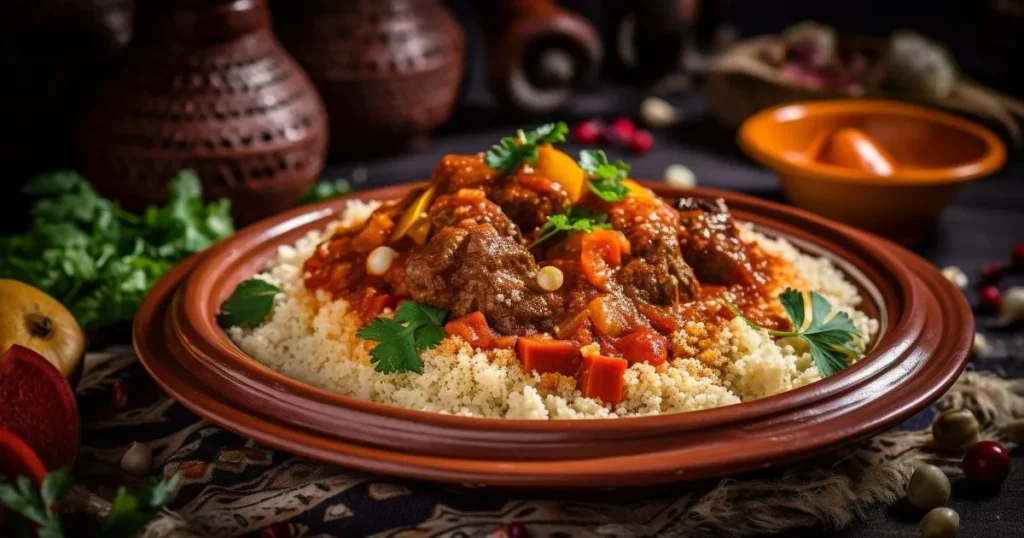
Couscous serves as the foundation for countless Moroccan meals, with regional variations reflecting local ingredients and traditions:
Friday Couscous (Couscous Tfaya)
The traditional Friday meal featuring seven vegetables:
Traditional Vegetables:
- Turnips and carrots
- Zucchini and yellow squash
- Cabbage and onions
- Chickpeas and tomatoes
Preparation Method:
- Steam couscous to perfection
- Prepare vegetable and meat stew separately
- Combine flavors in final presentation
- Serve with harissa and preserved vegetables
Royal Couscous
An elaborate version featuring multiple proteins and vegetables:
Protein Combinations:
- Lamb, chicken, and merguez sausage
- Seasonal vegetables arranged by color
- Rich, spiced broth
- Elaborate presentation reflecting special occasions
Pastilla: The Crown Jewel of Moroccan Pastry

Pastilla represents the pinnacle of Moroccan pastry artistry, combining delicate phyllo dough with rich, spiced fillings:
Traditional Pigeon Pastilla
The classic version showcasing traditional techniques:
Filling Components:
- Pigeon or chicken: Slowly braised with spices
- Almonds: Ground and sweetened with sugar and cinnamon
- Eggs: Scrambled with herbs and spices
- Phyllo pastry: Paper-thin layers creating delicate texture
Assembly Process:
- Layer pastry in circular pan
- Add protein layer with cooking liquid
- Spread almond mixture evenly
- Top with egg mixture and final pastry layers
- Bake until golden and crispy
Seafood Pastilla
Modern variation showcasing coastal influences:
Contemporary Adaptations:
- Fresh fish and shellfish combinations
- Herb-forward flavor profiles
- Lighter preparation methods
- Individual portion presentations
Harira: Morocco’s Beloved Soup
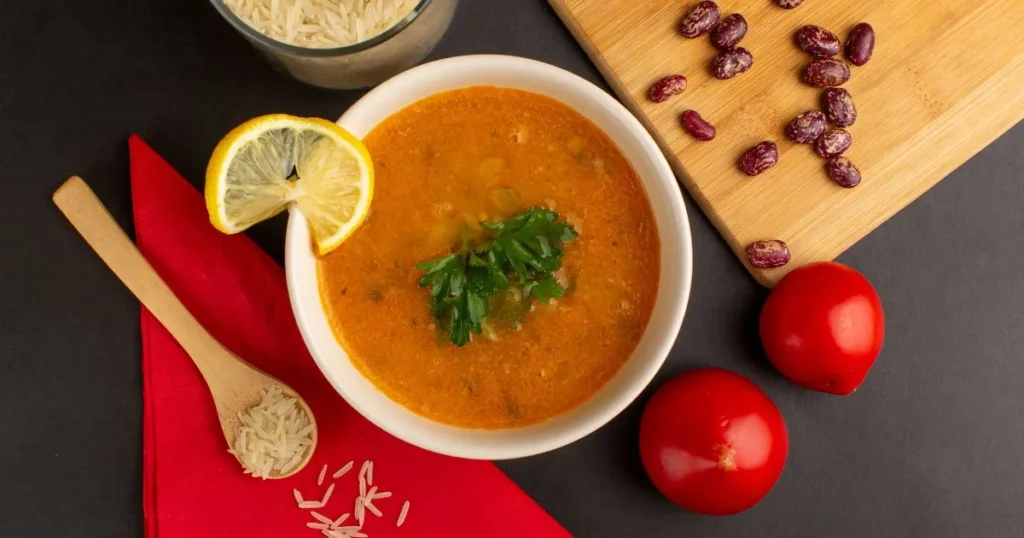
Harira carries deep cultural importance in Morocco, especially throughout Ramadan:
Essential Ingredients:
- Tomatoes: Fresh and tomato paste for depth
- Lentils and chickpeas: Protein and substance
- Fresh herbs: Cilantro, parsley, and celery
- Vermicelli: Added in final cooking stage
- Lemon juice: Brightens flavors before serving
Cultural Significance:
- Ramadan tradition: Breaking fast with harira
- Family recipes: Passed down through generations
- Regional variations: Different provinces add unique touches
- Comfort food: Enjoyed year-round for its nourishing qualities
Drinks: Moroccan Beverage Traditions
Mint Tea: The National Drink
Moroccan mint tea (Atay) symbolizes hospitality, friendship, and cultural tradition:
Traditional Preparation:
- Rinse the tea: Green tea rinsed with boiling water
- Add mint: Fresh spearmint leaves (never dried)
- Sweeten: Generous amount of sugar cubes
- Steep: Allow flavors to meld for 3-5 minutes
- Serve: Pour from height to create foam
Cultural Aspects:
- Three glasses: Traditional serving representing friendship
- Ceremonial pouring: Demonstrates skill and respect
- Social bonding: Central to Moroccan hospitality
- Daily ritual: Consumed throughout the day
Traditional Beverages
Moroccan Coffee
Strong, spiced coffee often served in small glasses:
Preparation Variations:
- Café Cassé: Coffee with a dash of milk
- Café Noir: Strong black coffee
- Spiced versions: With cardamom, cinnamon, or ginger
Fresh Fruit Juices
Morocco’s climate produces exceptional fruits for juicing:
Popular Combinations:
- Orange juice: Fresh-squeezed from local oranges
- Pomegranate: Rich, antioxidant-packed refreshment
- Mixed fruit: Seasonal combinations
- Almond milk: Traditional non-dairy option
Fermented Beverages
Traditional drinks with cultural significance:
Lben: Fermented buttermilk, refreshing and probiotic Mahia: Fig-based alcoholic beverage (in non-Muslim communities)
Desserts: Sweet Endings to Moroccan Meals
Traditional Pastries and Cookies
Moroccan sweets reflect the country’s love for delicate pastries and aromatic spices:
Chebakia
Intricate flower-shaped cookies traditionally served during Ramadan:
Preparation Method:
- Dough: Flour, eggs, and orange blossom water
- Shaping: Complex braiding technique creating flower patterns
- Frying: Deep-fried until golden and crispy
- Final step: Coated in honey and topped with sesame seeds
Gazelle Horns (Cornes de Gazelle)
Crescent-shaped cookies filled with almond paste:
Components:
- Pastry: Delicate dough rolled paper-thin
- Filling: Almond paste flavored with orange blossom water
- Finishing: Light dusting of powdered sugar
Makroudh
Semolina cakes filled with dates:
Traditional Preparation:
- Semolina dough: Mixed with olive oil and orange blossom water
- Date mixture: Blended dates seasoned with cinnamon and rose water
- Coating: Honey syrup for sweetness and preservation
Milk-Based Desserts
Muhallabia
Creamy milk pudding with rose water and pistachios:
Ingredients:
- Milk: Full-fat for richness
- Rice flour: For thickening
- Rose water: Floral aromatics
- Pistachios: Chopped for garnish
Riz au Lait
Moroccan rice pudding with distinctive flavoring:
Preparation:
- Short-grain rice: Cooked slowly in milk
- Cinnamon: Warm spice essential to the dish
- Orange blossom water: Floral finish
- Almonds: Sliced for texture and presentation
Fruit-Based Desserts
Fresh Fruit Salads
Seasonal fruits enhanced with traditional flavors:
Popular Combinations:
- Oranges: With cinnamon and orange blossom water
- Melons: With mint and lime juice
- Mixed fruits: Seasonal selections with honey
- Dates: Stuffed with nuts and honey
Etiquette: Navigating Moroccan Dining Customs
Traditional Dining Practices
Understanding Moroccan dining etiquette enhances the cultural experience and shows respect for local customs:
The Moroccan Table Setting
Traditional Elements:
- Low round table: Often ornately decorated
- Floor cushions: Comfortable seating arrangements
- Communal plates: Shared dishes fostering community
- Individual bread: Personal portions of fresh bread
Hand Washing Ritual
Proper Procedure:
- Before eating: Wash hands with soap and water
- During meal: Rose water and towels provided
- After eating: Thorough cleaning before tea service
- Significance: Cleanliness is both practical and spiritual
Eating Customs and Manners
Bread Etiquette
Bread holds sacred significance in Moroccan culture:
Respectful Practices:
- Never waste bread: Finish all portions served
- Use as utensil: Tear pieces to scoop food
- Blessing practice: Some families bless bread before eating
- Storage respect: Never place bread upside down
Sharing and Community
Communal Dining Rules:
- Eat from your section: Don’t reach across communal plates
- Offer to others: Share choice pieces with guests
- Pace yourself: Eat at a comfortable, social pace
- Express gratitude: Compliment the cook and show appreciation
Tea Service Protocol
Proper Tea Ceremony:
- Accept graciously: Refusing tea can be considered rude
- Three glasses: Traditional to accept at least one
- Compliment preparation: Acknowledge the host’s skill
- Conversation: Tea time is for socializing and bonding
Guest and Host Responsibilities
Host Obligations
Moroccan hospitality is legendary and comes with specific expectations:
Host Duties:
- Abundant food: Prepare more than guests can eat
- Quality ingredients: Use the best available ingredients
- Gracious service: Attend to guests’ needs throughout meal
- Comfortable environment: Ensure guests feel welcome and relaxed
Guest Courtesies
Guests also have responsibilities in Moroccan dining culture:
Appropriate Behavior:
- Arrive punctually: Respect the host’s preparation time
- Dress appropriately: Modest, respectful clothing
- Participate actively: Engage in conversation and activities
- Express gratitude: Thank hosts verbally and through actions
Resources: Expanding Your Moroccan Culinary Journey
Recommended Cookbooks and Literature
Essential Moroccan Cookbooks
- “The Food of Morocco” by Paula Wolfert: Comprehensive guide to authentic recipes
- “Moroccan Modern” by Hassan M’Souli: Present-day versions of traditional recipes
- “Couscous and Other Good Food from Morocco” by Paula Wolfert: Focused on traditional techniques
- “The Moroccan Collection” by Hélène Gans: Beautiful photography and approachable recipes
Cultural and Historical References
- “In the Folds of the Flesh” by Tahar Ben Jelloun: Cultural context for Moroccan cuisine
- “The Caliph’s House” by Tahir Shah: Expat perspective on Moroccan food culture
- “Dreams of Trespass” by Fatema Mernissi: Women’s perspectives on Moroccan cooking
Online Resources and Communities
Websites and Blogs
- Moroccan Food Safari: Authentic recipes and cooking tips
- Taste of Maroc: Regional specialties and ingredient guides
- My Moroccan Food: Home cook perspectives and family recipes
- Moroccan Zest: Modern interpretations and dietary adaptations
Video Resources
- YouTube Channels: Several channels dedicated to Moroccan cooking
- Cooking Classes: Online instruction from Moroccan chefs
- Documentary Films: Cultural context and cooking demonstrations
Where to Find Ingredients
Specialty Stores
- Middle Eastern Markets: Often stock Moroccan spices and ingredients
- Online Retailers: Amazon, Williams Sonoma, and specialty importers
- Neighborhood Moroccan Restaurants: Many offer ingredients and spice mixtures for sale
- International Sections: Major supermarkets increasingly stock Moroccan ingredients
Essential Ingredient Checklist
Spices to Stock:
- Ras el Hanout blend
- Preserved lemons
- Harissa paste
- Saffron threads
- Rose water and orange blossom water
Equipment Recommendations:
- Tagine: Authentic clay or modern alternatives
- Couscoussier: Traditional steaming pot
- Mortar and pestle: For grinding spices
- Fine-mesh strainer: For couscous preparation
Cooking Classes and Experiences
International Options
- Local culinary schools: Many offer Moroccan cooking courses
- Community centers: Cultural organizations often host cooking classes
- Private chefs: Individual instruction for personalized learning
- Food festivals: Hands-on experiences at cultural events
Travel Opportunities
- Culinary tours: Specialized food-focused travel programs
- Cooking riads: Accommodations offering cooking instruction
- Market tours: Guided shopping experiences in Moroccan markets
- Family experiences: Staying with Moroccan families
Frequently Asked Questions
General Questions About Moroccan Cuisine
Q: Is Moroccan food spicy hot?A: Moroccan dishes contain numerous spices yet are typically mild rather than fiery hot. The complexity comes from aromatic spices rather than chili peppers, though harissa can add heat for those who enjoy it.
Q: What makes Moroccan cuisine unique? A: The special mix of Berber, Arab, Moorish, and French cooking influences produces a one-of-a-kind culinary style. The combination of sweet and savory flavors, preserved components, and slow-cooking methods distinguishes Moroccan cuisine.
Q: Are there vegetarian options in Moroccan cuisine? A: Absolutely! Many traditional Moroccan dishes are naturally vegetarian, including vegetable tagines, couscous with vegetables, various salads, and legume-based preparations.
Cooking and Preparation Questions
Q: Is special equipment required for cooking Moroccan dishes? A: While a tagine and couscoussier are helpful, you can adapt most recipes using standard cookware. A heavy-bottomed pot with a tight-fitting lid can substitute for a tagine, and a steamer basket can work for couscous.
Q: Where can I find authentic Moroccan ingredients? A: Middle Eastern markets, online specialty retailers, and increasingly, regular supermarkets stock Moroccan ingredients. Many items like preserved lemons can be made at home.
Q: How long does it take to prepare traditional Moroccan dishes? A: Many Moroccan dishes are slow-cooked, requiring 1-3 hours for optimal flavor development. However, the active preparation time is often minimal, making them perfect for relaxed cooking.
Cultural and Dietary Questions
Q: What is the significance of tea in Moroccan culture? A: Tea is central to Moroccan hospitality and social interaction. Preparing and serving mint tea is a ritual that expresses respect and friendship.
Q: Are there gluten-free options in Moroccan cuisine? A: Many traditional dishes are naturally gluten-free, including tagines, rice dishes, and certain salads. However, couscous and many breads contain gluten, so careful selection is necessary.
Q: How do Moroccans typically structure their meals? A: Traditional Moroccan meals often feature multiple dishes served simultaneously, with bread as a constant accompaniment. Meals are social events emphasizing sharing and community.
Discover the rich tapestry of Moroccan cuisine through authentic recipes, traditional techniques, and cultural insights. From the bustling markets of Marrakech to the coastal flavors of Casablanca, embark on a culinary journey that will transform your understanding of this magnificent North African cuisine. Whether you’re preparing your first tagine or perfecting your couscous technique, the world of Moroccan cooking offers endless opportunities for exploration and enjoyment.

